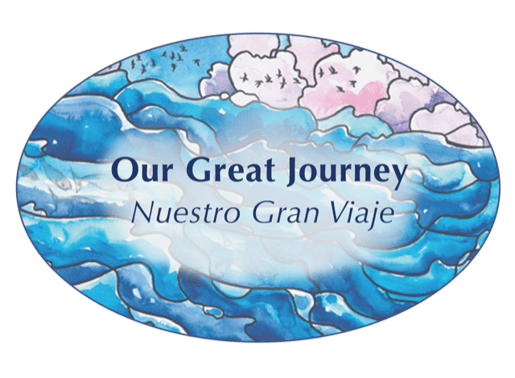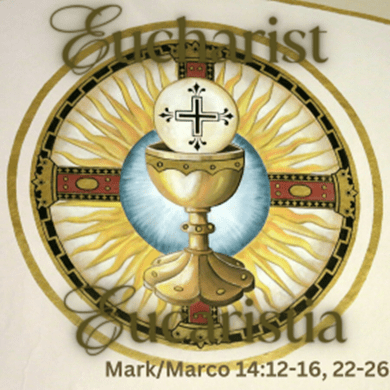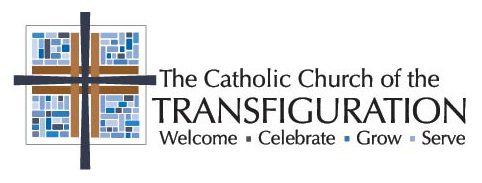
Our Great Journey
This week our theme is “Eucharist/Eucaristia” based on Mark 14:12-16, 22-26 / Marco 14:12-16, 22-26.
All pray the Sign of the Cross
Lord Jesus Christ, out of love for us you gave us the gift of your Body and Blood so that we may be saved from our sins. When we celebrate the Eucharist, we give you thanks. May we try to do what is right by imitating you, who lives and reigns forever, Amen.
Using the Bible, invite a family member to read the Gospel aloud.
Things to talk about:
- In what way does this Gospel reading explain our belief in the real presence of Jesus in the Eucharist?
- Why is receiving the Eucharist special to you? Share a time when you felt Jesus powerfully present after receiving the Eucharist.
- In what way have you been Eucharist for others?
Things to do:
- Ask each family member who has received their First Communion to recall their feelings on that special day. What details can you remember?
- For younger kids, create a Monstrance craft, click HERE.
- As a family work on this True Presence craft, click HERE.
- Make bread today and connect to this Gospel.
- As a family, listen to the song I Am Yours—Consume Me Completely. You should be able to find the song on YouTube or wherever you stream music. Reflect on what these lyrics say about the Eucharist.
- Find a time to go to Eucharistic Adoration as a family this week. Prepare ahead of time by explaining what Eucharistic Adoration is and what to do when you get there.
Closing Prayer
In the name of the Father and of the Son and of the Holy Spirit. Amen.
Lord Jesus, who in the Eucharist make your dwelling among us and become our travelling companion,
sustain Our Christian communities so that they may be ever more open to listening
and accepting your Word.
May they draw from the Eucharist a renewed commitment to spreading in society,
by the proclamation of your Gospel, the signs and deeds of an attentive and active charity.
Lord Jesus: give us your joy, give us your peace. Stay with us, Lord!
You alone have the words of eternal life!
[Taken from a Homily Pope John Paul II gave in Cremona, Italy, June 21,1992; Printed in L’Osservatore Romano July 15, 1992]
Name those who need our prayers. Close with the Sign of the Cross.

Catholic Insights
Today’s feast is also called “Corpus Christi,” Latin for the body of Christ.
This Gospel invites deep reflection on the mystery of the Eucharist. It is truly wondrous that Jesus comes to us individually and as community directly and completely through the simple gifts of bread and wine. This bread and wine are given by Jesus as his Body and Blood in the New Covenant.
The unleavened bread symbolizes that the Hebrew people left Egypt on the night o the tenth plague — they could not wait for their bread to rise. The wine symbolizes the blood of the lamb that the Hebrew people used to mark the outside of their front door so that the angel of death would “pass over” the Hebrew children. At the Passover meal at the Last Supper, Jesus does not use the traditional Passover language. Instead he says the bread is his body and the wine is his blood. Jesus states a new covenant between the people and God. The new covenant is an extension of that promise of salvation to all.
Every time we received the consecrated bread and wine during the celebration of the Mass, we are receiving Jesus himself. The resurrected Christ comes to us fully and completely through the sacred transformation of the bread and wine.
At every Mass, the priest uses the exact words that Jesus said at the Last Supper to transform the bread and wine into the Body and Blood of Jesus. These are called the Words of Institution:
Take this, all of you, and eat of it: for this is my body which will be given up for you.
Take this, all of you, and drink from it: for this is the chalice of my blood, the blood of the new and eternal covenant. which will be poured out for you and for many for the forgiveness of sins.
Do this in memory of me.
Listen for those words when you attend Mass. After receiving Jesus, we are called to be Eucharist to others.
Did you know?… that on this solemnity, the community of faith often processes with the Blessed Sacrament and has Adoration? At the end of Mass, the priest places the Body of Christ in a display vessel called a monstrance. This is taken in a procession or placed on the altar for Adoration of the Blessed Sacrament. The word “Eucharist” comes from the Greek word, eucharistia, meaning thanksgiving…. and yes, we are so thankful for the gift of Jesus.

Leave a Reply